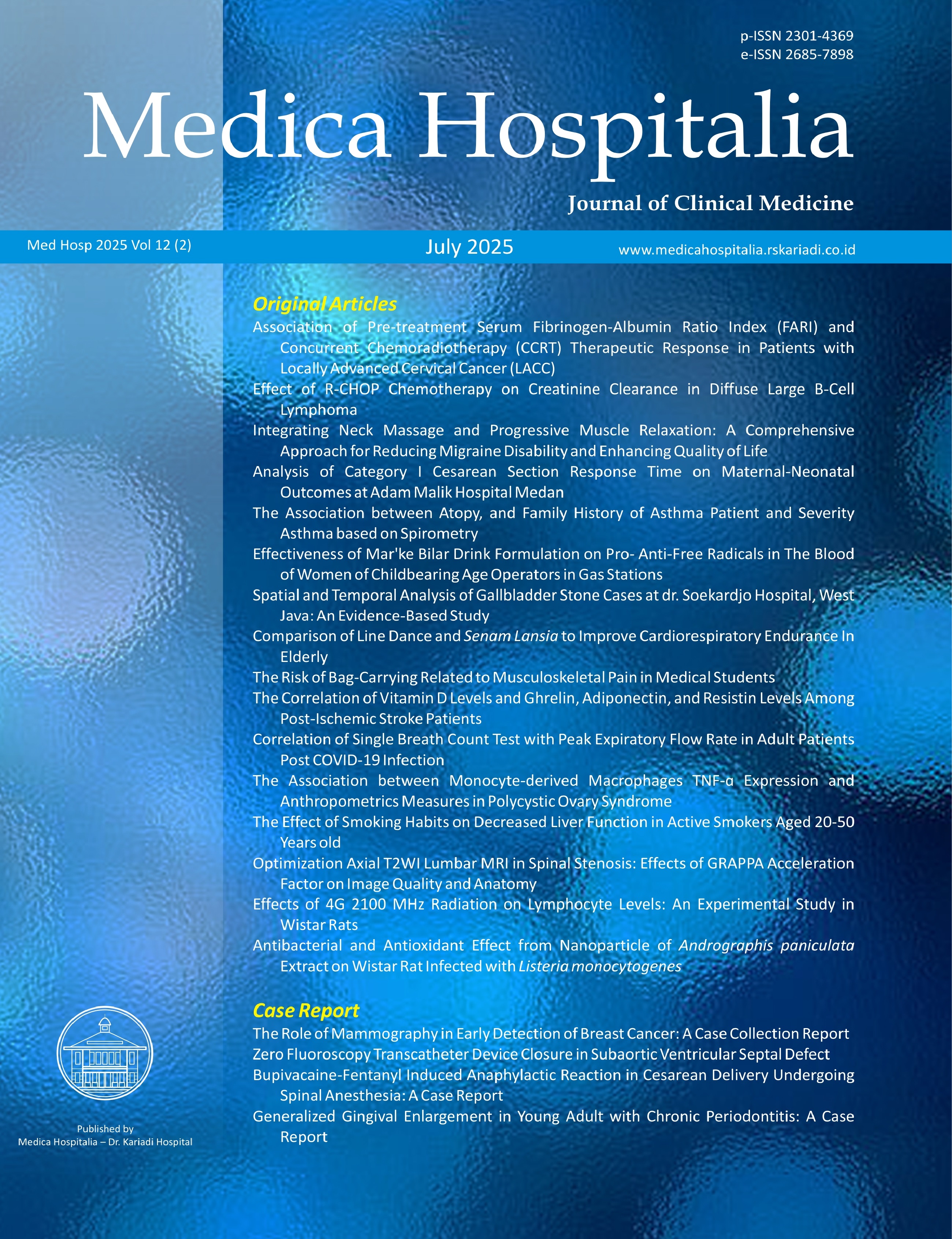The Association between Atopy, and Family History of Asthma Patient and Severity Asthma based on Spirometry
DOI:
https://doi.org/10.36408/mhjcm.v12i2.1231Keywords:
Asthma, Atopy History, Degree of Obstruction, Environmental Risk Factors, Spirometric ParametersAbstract
BACKGROUND: Asthma is a chronic inflammatory respiratory condition characterized by fluctuating symptoms, which often leads to diagnostic challenges. Accurate assessment and interpretation of clinical and functional parameters are essential to improve disease management and patient outcomes.
AIMS: This study aims to analyze the demographic and clinical profiles of asthma patients, particularly investigating the relationships among the degree of airway obstruction, spirometric indices, smoking exposure, environmental risk factors, atopic history, and family history, to better understand the multifactorial nature of asthma.
METHOD: A retrospective descriptive-analytic study was conducted using medical records of 107 asthma patients treated at the Outpatient Installation of the Lung Polyclinic, Wlingi General Hospital, Blitar Regency, from 2021 to 2022. Descriptive statistics were used to summarize demographic and clinical data, and Spearman correlation tests assessed associations between variables.
RESULTS: A high proportion of patients had a history of smoking, with 22.4% being active and 52.3% passive smokers. However, no significant correlation was found between smoking status and asthma control. Common environmental risk factors included exposure to dust and cold air, though these did not consistently correlate with asthma exacerbations. Significant correlations were identified between the severity of airway obstruction and spirometric parameters such as FEV1, FVC, FEV1/FVC ratio, PEF, FEF 25, FEF 50, and FEF 75, confirming the impact of airflow limitation on lung function. No significant associations were found between asthma stability and atopic or family history.
CONCLUSION: The findings underscore the complexity of asthma pathophysiology, where airflow obstruction is clearly linked to reduced spirometric function, but other factors such as smoking, environmental exposures, atopy, and family history do not show consistent predictive value for asthma control. These results highlight the need for a comprehensive and individualized approach in asthma diagnosis and management.
Downloads
References
1. GINA. https://ginasthma.org/. 2023. Global strategy for asthma management and prevention.
2. Chaker L, Bianco AC, Jonklaas J, Peeters RP. Hypothyroidism. The Lancet. 2017 Sep;390(10101):1550–62.
3. Agache I. Severe asthma phenotypes and endotypes. Semin Immunol. 2019 Dec;46:101301.
4. Porsbjerg C, Melén E, Lehtimäki L, Shaw D. Asthma. The Lancet. 2023 Mar;401(10379):858–73.
5. Morosco G, Kiley J. Preface. Journal of Allergy and Clinical Immunology. 2007 Nov;120(5):S93.
6. Bhattacharyya P, Das SK, Saha D,, Bhattacherjee PD. Can long term add-on doxycycline improve lung function in asthma: The result of an open prospective real-world observation. The Journal of Association of Chest Physicians. 2023;85–91.
7. Gray KW. Pediatric Asthma for the Primary Care Physician. Primary Care: Clinics in Office Practice. 2021 Sep;48(3):379–94.
8. Putrianti CT. Pengaruh Faktor Kepribadian (Agreeableness, Conscientiousness, dan Neuroticism) Terhadap Kepemimpinan Etis pada Akuntan Publik di Kota Semarang. Unika Soegijapranata Semarang; 2016.
9. Woods JT, Walter RJ, Houle MC, Barber BS, Morris MJ. The Effect of Deployment on Pulmonary Function in Military Personnel With Asthma. Mil Med. 2022 Jan 4;187(1–2):e116–21.
10. Ali Z, Ulrik CS. Obesity and asthma: a coincidence or a causal relationship? A systematic review. Respir Med. 2013;107(9):1287–300.
11. Calcaterra V, Verduci E, Ghezzi M, Cena H, Pascuzzi MC, Regalbuto C, et al. Pediatric obesity-related asthma: The role of nutrition and nutrients in prevention and treatment. Nutrients. 2021;13(11):3708.
12. Zheng X yan, Ding H, Jiang L na, Chen S wei, Zheng J ping, Qiu M, et al. Association between air pollutants and asthma emergency room visits and hospital admissions in time series studies: a systematic review and meta-analysis. PLoS One. 2015;10(9):e0138146.
13. Somayaji R, Chalmers JD. Just breathe: a review of sex and gender in chronic lung disease. European Respiratory Review. 2022;31(163).
14. He Z, Wu H, Zhang S, Lin Y, Li R, Xie L, et al. The association between secondhand smoke and childhood asthma: A systematic review and meta-analysis. Pediatr Pulmonol. 2020;55(10):2518–31.
15. Tagiyeva N, Sheikh A. Domestic exposure to volatile organic compounds in relation to asthma and allergy in children and adults. Expert Rev Clin Immunol. 2014;10(12):1611–39.
16. Predieri B, Iughetti L, Bernasconi S, Street ME. Endocrine disrupting chemicals’ effects in children: what we know and what we need to learn? Int J Mol Sci. 2022;23(19):11899.
17. Ye G, Baldwin DS, Hou R. Anxiety in asthma: a systematic review and meta-analysis. Psychol Med. 2021;51(1):11–20.
18. van de Loo KFE, van Gelder MMHJ, Roukema J, Roeleveld N, Merkus PJFM, Verhaak CM. Prenatal maternal psychological stress and childhood asthma and wheezing: a meta-analysis. European Respiratory Journal. 2016;47(1):133–46.
19. Soraya N, Anam MS, Anam MS. Hubungan Riwayat Atopik Orang Tua Dan Kejadian Asma Pada Anak Usia 13-14 Tahun Di Semarang. Faculty of Medicine Diponegoro University; 2014.
20. CETEMEN A, YEN.IGÜN A, ÜNÜVAR T, GÜLTEK.IN B. The relationship between obesity, asthma and atopy in children aged 6-18 years. Asthma Allergy Immunology. 2022;10(3):134–42.
21. London SJ, James Gauderman W, Avol E, Rappaport EB, Peters JM. Family History and the Risk of Early-Onset Persistent, Early-Onset Transient, and Late-Onset Asthma. Epidemiology. 2001 Sep;12(5):577–83.
22. Yavuzyilmaz F, Ozdogan S, Kaya A, Karadeniz P, Topkara MG. The effect of atopy on asthma severity and asthma control in children with asthma. Ç EEAH TipBülteni. 2017;51(1):56–62.
23. Tohidinik HR, Mallah N, Takkouche B. History of allergic rhinitis and risk of asthma; a systematic review and meta-analysis. World Allergy Organization Journal. 2019;12(10):100069.
24. Burbank AJ, Sood AK, Kesic MJ, Peden DB, Hernandez ML. Environmental determinants of allergy and asthma in early life. Journal of Allergy and Clinical Immunology. 2017;140(1):1–12.
25. Shen SY, Xiao WQ, Lu JH, Yuan MY, He JR, Xia HM, et al. Early life vitamin D status and asthma and wheeze: a systematic review and meta-analysis. BMC Pulm Med. 2018;18(1):1–18.
26. Rumpel JA, Ahmedani BK, Peterson EL, Wells KE, Yang M, Levin AM, et al. Genetic ancestry and its association with asthma exacerbations among African American subjects with asthma. Journal of allergy and clinical immunology. 2012;130(6):1302–6.
Additional Files
Published
How to Cite
Issue
Section
Citation Check
License
Copyright (c) 2025 Zata Dini, Susanthy Djajalaksana, Aditya Sri Listyoko, M. Yusuf Musthafa, Didik Purbandiyono, Adrian Yusdianto, Adlan Pratama Binharyanto, Cindy Carrissa Primaputri, Ilham Revan Ananda, Marsha Nurandhini, Muli Yaman, Reza Aditya Mahendra (Author)

This work is licensed under a Creative Commons Attribution-ShareAlike 4.0 International License.
Copyrights Notice
Copyrights:
Researchers publishing manuscrips at Medica Hospitalis: Journal of Clinical Medicine agree with regulations as follow:
Copyrights of each article belong to researchers, and it is likewise the patent rights
Researchers admit that Medica Hospitalia: Journal of Clinical Medicine has the right of first publication
Researchers may submit manuscripts separately, manage non exclusive distribution of published manuscripts into other versions (such as: being sent to researchers’ institutional repository, publication in the books, etc), admitting that manuscripts have been firstly published at Medica Hospitalia: Journal of Clinical Medicine
License:
Medica Hospitalia: Journal of Clinical Medicine is disseminated based on provisions of Creative Common Attribution-Share Alike 4.0 Internasional It allows individuals to duplicate and disseminate manuscripts in any formats, to alter, compose and make derivatives of manuscripts for any purpose. You are not allowed to use manuscripts for commercial purposes. You should properly acknowledge, reference links, and state that alterations have been made. You can do so in proper ways, but it does not hint that the licensors support you or your usage.
























